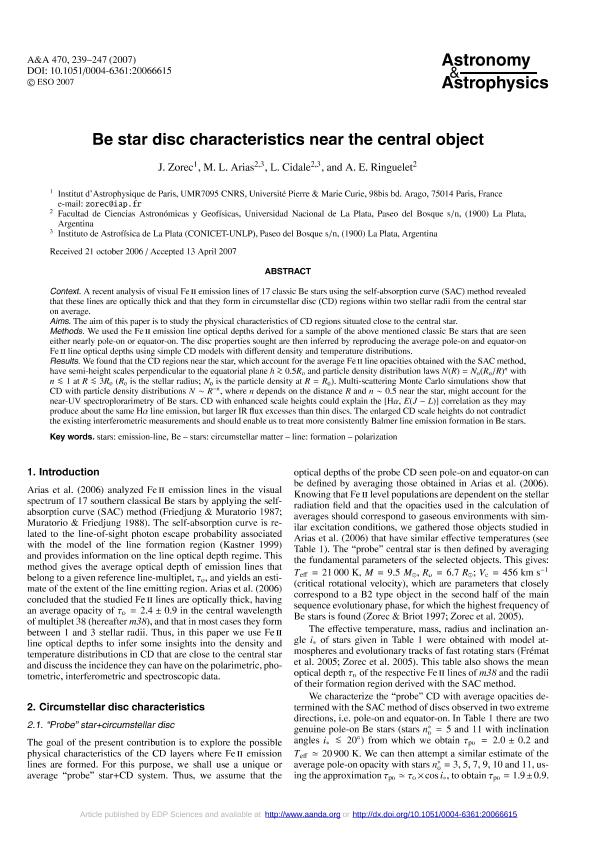Mostrar el registro sencillo del ítem
dc.contributor.author
Zorec, J.
dc.contributor.author
Arias, María Laura

dc.contributor.author
Cidale, Lydia Sonia

dc.contributor.author
Ringuelet, Adela Emilia

dc.date.available
2018-03-07T19:41:50Z
dc.date.issued
2007-07
dc.identifier.citation
Zorec, J.; Arias, María Laura; Cidale, Lydia Sonia; Ringuelet, Adela Emilia; Be star disc characteristics near the central object; EDP Sciences; Astronomy and Astrophysics; 470; 1; 7-2007; 239-247
dc.identifier.issn
0004-6361
dc.identifier.uri
http://hdl.handle.net/11336/38181
dc.description.abstract
Context. A recent analysis of visual Fell emission lines of 17 classic Be stars using the self-absorption curve (SAC) method revealed that these lines are optically thick and that they form in circumstellar disc (CD) regions within two stellar radii from the central star on average. Aims. The aim of this paper is to study the physical characteristics of CD regions situated close to the central star. Methods. We used the Fell emission line optical depths derived for a sample of the above mentioned classic Be stars that are seen either nearly pole-on or equator-on. The disc properties sought are then inferred by reproducing the average pole-on and equator-on Fen line optical depths using simple CD models with different density and temperature distributions. Results. We found that the CD regions near the star, which account for the average Fe II line opacities obtained with the SAC method, have semi-height scales perpendicular to the equatorial plane h ≳ 0.5Ro and particle density distribution laws N(R) = No(Ro/R)n with n l∼ 1 at R ≲ 3Ro (Ro is the stellar radius; No is the particle density at R = Ro). Multi-scattering Monte Carlo simulations show that CD with particle density distributions N ∼ R-n, where n depends on the distance R and n ∼ 0.5 near the star, might account for the near-UV spectroplorarimetry of Be stars. CD with enhanced scale heights could explain the [Hα, E(J - L)] correlation as they may produce about the same Hα line emission, but larger IR flux excesses than thin discs. The enlarged CD scale heights do not contradict the existing interferometric measurements and should enable us to treat more consistently Balmer line emission formation in Be stars.
dc.format
application/pdf
dc.language.iso
eng
dc.publisher
EDP Sciences

dc.rights
info:eu-repo/semantics/openAccess
dc.rights.uri
https://creativecommons.org/licenses/by-nc-sa/2.5/ar/
dc.subject
Line: Formation
dc.subject
Polarization
dc.subject
Stars: Circumstellar Matter
dc.subject
Stars: Emission-Line, Be
dc.subject.classification
Astronomía

dc.subject.classification
Ciencias Físicas

dc.subject.classification
CIENCIAS NATURALES Y EXACTAS

dc.title
Be star disc characteristics near the central object
dc.type
info:eu-repo/semantics/article
dc.type
info:ar-repo/semantics/artículo
dc.type
info:eu-repo/semantics/publishedVersion
dc.date.updated
2018-03-06T15:14:55Z
dc.journal.volume
470
dc.journal.number
1
dc.journal.pagination
239-247
dc.journal.pais
Francia

dc.journal.ciudad
Les Ulis, Francia
dc.description.fil
Fil: Zorec, J.. Universite Pierre et Marie Curie; Francia
dc.description.fil
Fil: Arias, María Laura. Consejo Nacional de Investigaciones Científicas y Técnicas. Centro Científico Tecnológico Conicet - La Plata. Instituto de Astrofísica La Plata. Universidad Nacional de La Plata. Facultad de Ciencias Astronómicas y Geofísicas. Instituto de Astrofísica La Plata; Argentina
dc.description.fil
Fil: Cidale, Lydia Sonia. Consejo Nacional de Investigaciones Científicas y Técnicas. Centro Científico Tecnológico Conicet - La Plata. Instituto de Astrofísica La Plata. Universidad Nacional de La Plata. Facultad de Ciencias Astronómicas y Geofísicas. Instituto de Astrofísica La Plata; Argentina
dc.description.fil
Fil: Ringuelet, Adela Emilia. Universidad Nacional de la Plata. Facultad de Ciencias Astronómicas y Geofísicas; Argentina. Consejo Nacional de Investigaciones Científicas y Técnicas; Argentina
dc.journal.title
Astronomy and Astrophysics

dc.relation.alternativeid
info:eu-repo/semantics/altIdentifier/doi/http://dx.doi.org/10.1051/0004-6361:20066615
dc.relation.alternativeid
info:eu-repo/semantics/altIdentifier/url/https://www.aanda.org/articles/aa/abs/2007/28/aa6615-06/aa6615-06.html
Archivos asociados
